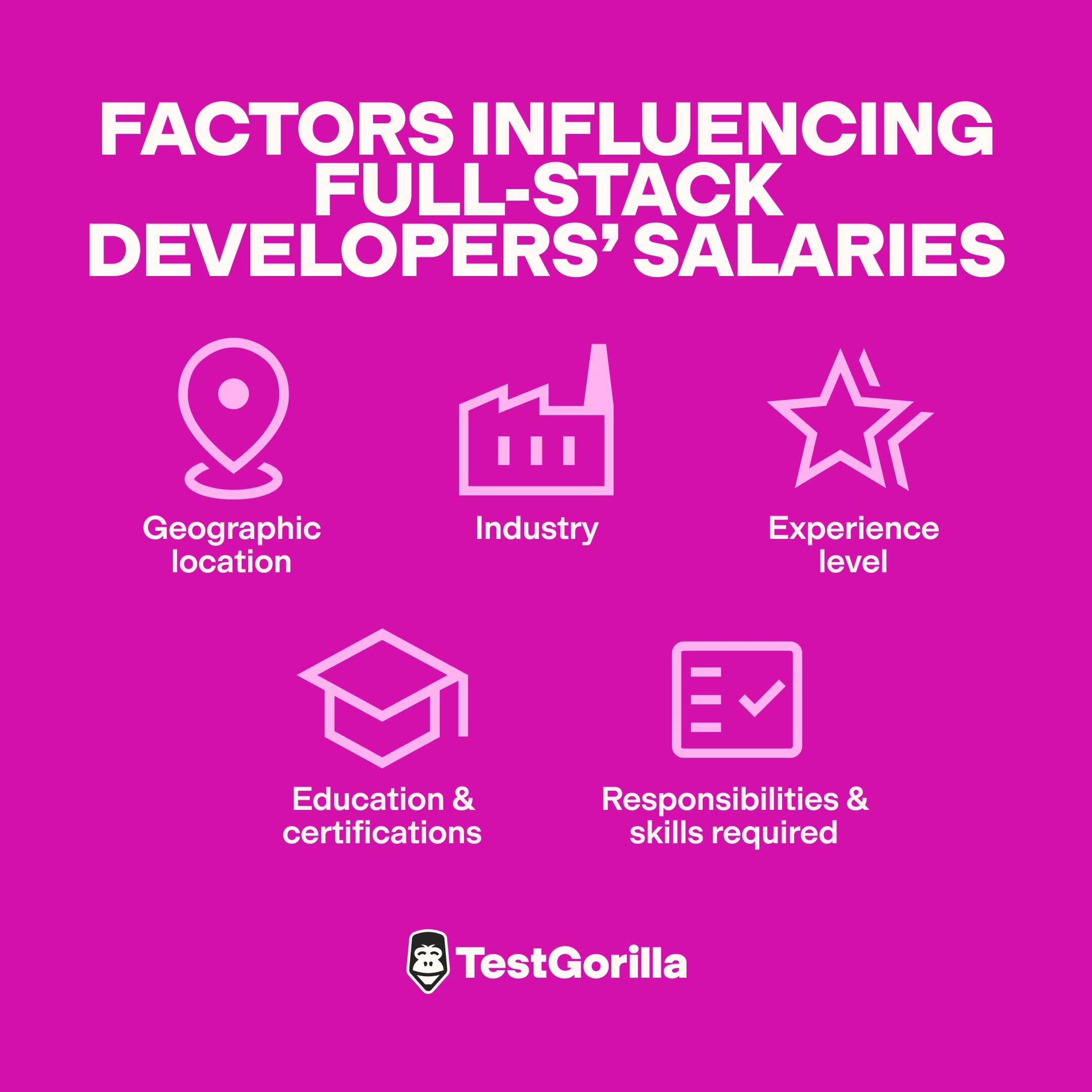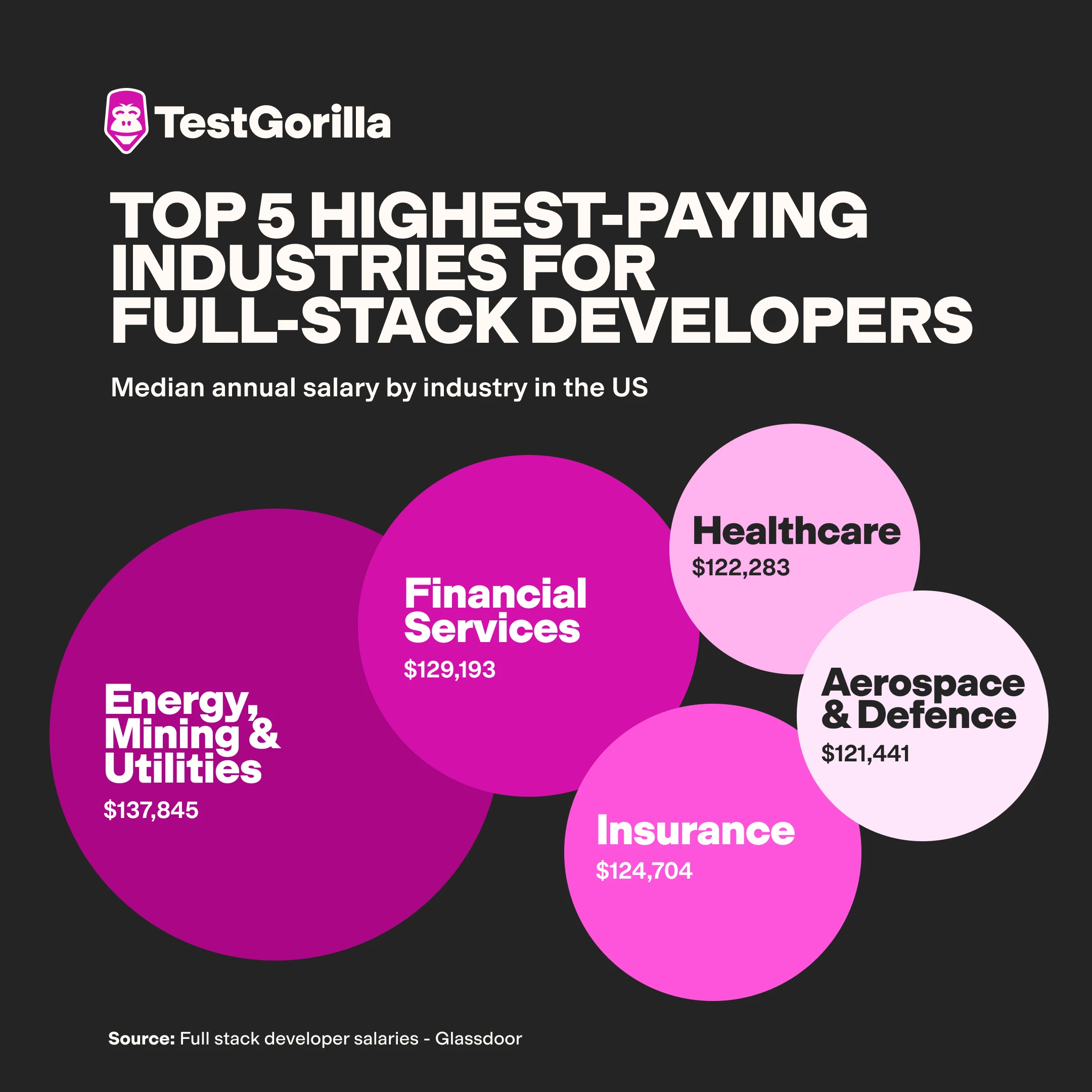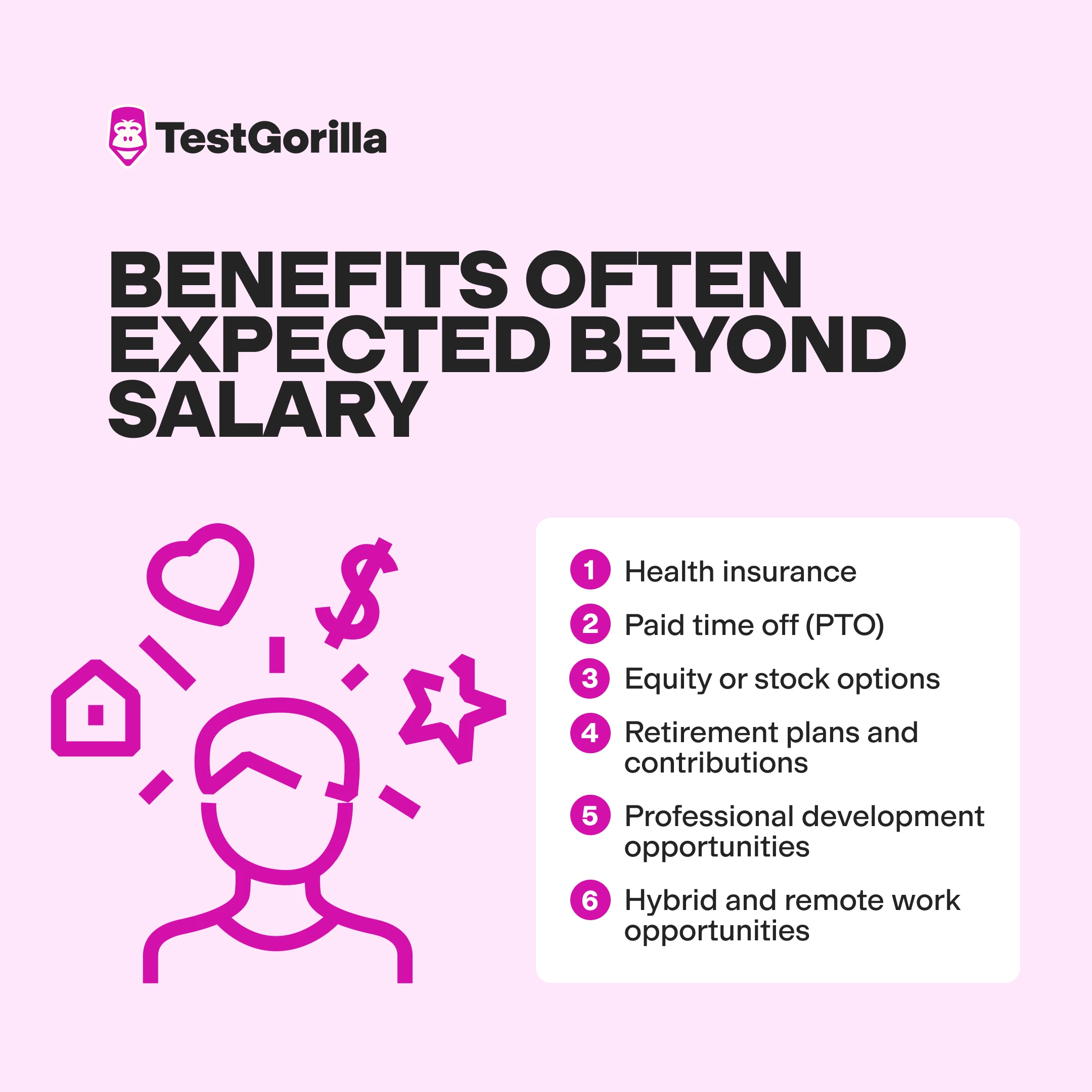What to pay a full-stack developer: Salary ranges, benefits, and market trends
Hiring the right full-stack developer at the right salary is no easy task. Market rates fluctuate, required skills vary by project and company, and benefits expectations can differ widely depending on where you live.
But with our guide on what to pay full-stack developers, you can breathe easy! We’ll dig into the data so you can confidently offer packages that attract and retain top tech talent.
How we researched this topic
We analyzed the latest U.S. salary data to bring you the most accurate information and key trends for full-stack developer compensation. We consulted sources including Glassdoor and Indeed and gathered data on factors like geographic location, industry, experience, and skills.
Key takeaways
The national average salary for full-stack developers varies significantly based on location, with tech hubs offering the highest pay.
There are differences across industries, too. Healthcare and finance pay higher than the education and non-profit sectors.
Mid-career full-stack developers typically earn up to 30% more than entry-level developers.
Non-monetary benefits – like equity and remote work – are increasingly important in attracting top talent.
National salary statistics for full-stack developers
Here’s a breakdown of average pay for full-stack developers based on statistics from Indeed:
Pay metric | Annual salary ($) | Hourly wage ($) |
Average | $127,420 | $54.58 |
Top 10% earners | $196,756 | $84.27 |
Bottom 10% earners | $82,518 | $35.34 |
The average salary can include both base salary and additional cash compensation, such as an annual bonus.
Factors influencing salaries
When determining what to pay a full-stack developer, don’t just take the baseline figures quoted above. Pay can be significantly impacted by:
Geographic location
Industry
Experience level
Education and certifications
Responsibilities and skills required
We’ll explore each in turn below.
Geographic location
First, let’s take a look at the highest-paying U.S. cities for full-stack developers:
City | Average annual salary ($) |
Durham, NC | $165,583 |
San Francisco, CA | $156,848 |
Los Angeles, CA | $139,123 |
Charlotte, NC | $138,074 |
Austin, TX | $135,550 |
Irving, TX | $130,300 |
McLean, VA | $127,136 |
Denver, CO | $124,094 |
Princeton, NJ | $110,542 |
Geographic pay variations are closely tied to the cost of living in each region. As a major tech hub with high living expenses, California – unsurprisingly – is home to two of the three highest-paying U.S. cities for full-stack developers.
Likewise, states with lower costs of living tend to offer less money. However, many full-stack developers are willing to make this tradeoff. Californians are moving to Texas to benefit from lower costs, and North Carolina could provide a good balance for full-stack developers looking for a lower cost of living than California.
Industry-specific pay data
Because full-stack developers in industries like healthcare and finance work with complex systems and data that need to be more secure, they tend to command higher salaries.
According to Glassdoor, the top five highest-paying industries for full-stack developers in the US are:
Industry | Median annual salary ($) |
Energy, Mining, & Utilities | $137,845 |
Financial Services | $129,193 |
Insurance | $124,704 |
Healthcare | $122,283 |
Aerospace & Defense | $121,441 |
Pay by experience and education
How many years of experience a full stack developer has – as well as their education – can also affect their salary.
Here’s a breakdown of average salary depending on years of experience, per Glassdoor:
Full-stack developer (0-1 year of experience): $61,000-$99,000
Mid-level full-stack developer (1-3 years of experience): $67,000-$106,000
Senior full-stack engineer (4-6 years of experience): $72,000-$113,000
Principal full-stack engineer (8+ years of experience): $146,000-$248,000
Vice president of engineering (8+ years of experience): $227,000-$396,000
Full-stack developers with the following qualifications may also expect more money:
AWS Certified Developer
Certified ScrumMaster (CSM)
Master’s Degree in Computer Science (MSc)
The best insights on HR and recruitment, delivered to your inbox.
Biweekly updates. No spam. Unsubscribe any time.
Benefits beyond salary
While salary is important, it packs less of a punch without a comprehensive benefits package. As with most other workers, full-stack developers value and will often expect the following benefits:
Health insurance. The Bureau of Labor Statistics indicates that U.S. companies provide around 72% of medical care benefits, including dental and vision. Developers working with screens for hours a day want to maintain their health and wellness so they can continue performing.
Paid time off (PTO). PTO – vacation, sick, and holiday leave – is a standard component of most benefits packages offered to full-stack developers. Time off is especially important for these professionals, who can experience high stress and long hours.
Equity or stock options. These give full-stack developers a real stake in a company’s success, offering a long-term incentive and a chance to build wealth. They’re great for tech startups and companies in high-growth sectors and can attract both early-career talent and seasoned developers looking for exciting new opportunities.
Retirement plans and contributions. These can help draw in long-term talent, as tech professionals value benefits that support financial stability and future planning.
Professional development opportunities. In an ever-evolving industry like software development, offering paid certifications and learning stipends is a great way to appeal to skilled professionals. This perk helps developers stay competitive and up-to-date with in-demand skills.
Hybrid and remote work opportunities. According to Gallup, over 80% of employees who can work remotely or in a hybrid model do. This means hybrid and remote work opportunities are particularly attractive – especially for full-stack developers who don’t need to be in an office to complete their work.
Elevate your recruitment game with talent assessments
Attracting and retaining skilled full-stack developers takes more than just a competitive pay packet. You need to source developers who know their TypeScript from their React use cases – but doing so isn’t always easy.
That’s where talent assessments come in. With a platform like TestGorilla, you can evaluate candidates’ coding skills, personality traits, cognitive abilities, and more – so you can make hiring decisions based on who they are and what they can do, not what their resumé looks like.
TestGorilla’s coding, problem-solving, and situational judgment tests are the perfect tools to hire across all full-stack developer roles, from junior to principal engineers. Our test library features more than 400 tests that you can combine to create the ideal assessment for your candidates.
Ready to make the leap into talent assessments? Sign up for a TestGorilla account today!
FAQs
How much do full-stack developers get paid?
The average salary for a full-stack developer in the U.S. is $68k-$122k per year base pay and $24k-$45k a year additional cash compensation, for a total of $92k-$167k a year, or $123K per year median total pay.
Do full-stack developers get paid more than other developers?
Yes. The average total pay (base salary plus additional compensation) for a full-stack developer is $123,224 per year. The average total pay for front end developers is $102,565 per year, while for back-end developers, it’s $110,146 per year.
Will AI replace full-stack developers?
No, AI won't replace full-stack developers anytime soon. However, AI might change the nature of full-stack development, as it can already assist with code generation, design, and automated testing.
You've scrolled this far
Why not try TestGorilla for free, and see what happens when you put skills first.





















